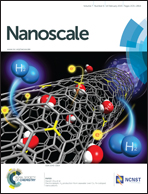Pulsed laser deposited porous nano-carpets of indium tin oxide and their use as charge collectors in core–shell structures for dye sensitized solar cells†
Abstract
Porous In2O3:Sn (ITO) films resembling from brush carpets to open moss-like discrete nanostructures were grown by pulsed laser deposition under low to high background gas pressures, respectively. The charge transport properties of these mesoporous substrates were probed by pulsed laser photo-current and -voltage transient measurements in N719 dye sensitized devices. Although the cyclic voltammetry and dye adsorption measurements suggest a lower proportion of electro-active dye molecules for films deposited at the high-end background gas pressures, the transient measurements indicate similar electron transport rates within the films. Solar cell operation was achieved by the deposition of a conformal TiO2 shell layer by atomic layer deposition (ALD). Much of the device improvement was shown to be due to the TiO2 shell blocking the recombination of photoelectrons with the electrolyte as recombination lifetimes increased drastically from a few seconds in uncoated ITO to over 50 minutes in the ITO with a TiO2 shell layer. Additionally, an order of magnitude increase in the electron transport rate in ITO/TiO2 (core/shell) films was observed, giving the core–shell structure a superior ratio of recombination/transport times.


 Please wait while we load your content...
Please wait while we load your content...